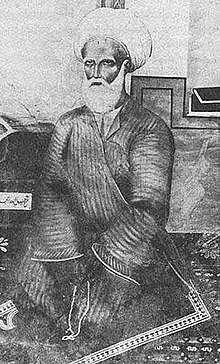
Back أحمد بن زين الدين الأحسائي Arabic احمد بن زين الدين الاحسائى ARZ Şeyx Əhməd Əhsai Azerbaijani شیخ احمد احسائی AZB আহমদ বিন জাইনুদ্দিন আল-আহসায়ী Bengali/Bangla Àhmad al-Ahsaí Catalan Ahmad al-Ahsā'ī German Ŝejĥo Ahmad Esperanto Ahmad al-Ahsa'i Spanish Xeikh Ahmad al-Ahsaí Basque
Ahmad al-Ahsa'i | |
|---|---|
الشيخ أحمد الإحسائي | |
 Ahmad bin Zayn al-Din al-Ahsáʼí | |
| Personal life | |
| Born | May 1753 |
| Died | 27 June 1826 (aged 72–73) |
| Resting place | Jannaṫ al-Baqīʻ Cemetery, Medina, Hijaz (Present-day Saudi Arabia) |
| Era | Qajar dynasty |
| Religious life | |
| Religion | Islam |
| Denomination | Twelver Shia |
| Movement | Shaykhism |
| Muslim leader | |
Shaykh Ahmad al-Ahsā'ī (Arabic: شيخ أحمد الأحسائي) (May 1753 ― 27 June 1826) was a prominent Islamic theologian and jurist who founded the influential Shaykhī school of Twelver Shi'ism, which attracted followers from throughout the Persian and Ottoman Empires.
He was a native of the Al-Ahsa region of eastern Arabia, educated in Bahrain and the theological centres of Najaf and Karbala. He spent 16 years in Iran, where he received the protection and patronage of princes of the Qajar dynasty.
Shaykh Ahmad diverged from the Usuli school on key issues related to Islamic eschatology, the role of the ulama, and the proper interpretation of the mystical hadith of the Twelve Imams. He claimed to derive his authority from the Imams, who communicated to him in visions. These divergences resulted in accusations of heresy from orthodox members of the Shia ulama, and instances of persecution against al-Ahsa'i and his followers occurred during and after his lifetime. His teachings were complex, thus he often practised Taqayya concealing his controversial ideas from his opponents.[1]
Al-Ahsa'i's chief disciple was Sayyid Kazim Rashti, who succeeded him as the leader of the distinct sect. Rashti, who also claimed to be guided by visions, consolidated the disparate Shaykhi followers, but did not appoint a successor himself. Shaykhism then became split between a conservative faction led by Karim Khan Kermani, and a more radical interpretation by Ali-Muhammad, better known as the Bāb, who claimed to be a new prophet to abrogate Islam. Many Shaykhis became Bābīs, most of whom later became Bahā'īs, who now number in the millions and consider the visions of al-Ahsa'i to be the first stirrings of their religion.[2]